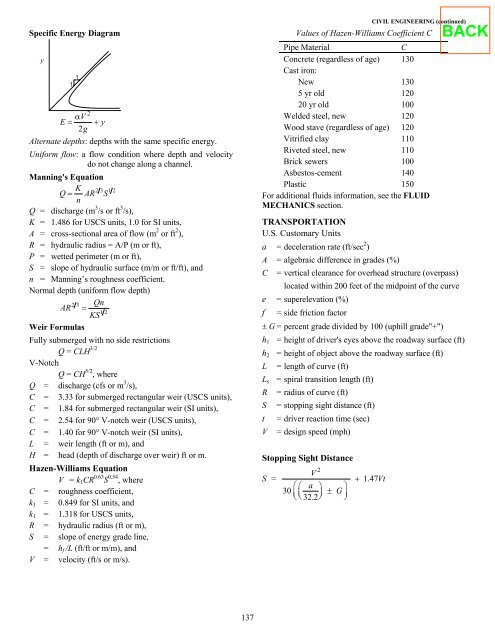fundamentals of engineering supplied-reference handbook - Ventech!
fundamentals of engineering supplied-reference handbook - Ventech!
fundamentals of engineering supplied-reference handbook - Ventech!
You also want an ePaper? Increase the reach of your titles
YUMPU automatically turns print PDFs into web optimized ePapers that Google loves.
Specific Energy Diagram<br />
y<br />
1<br />
1<br />
2<br />
αV<br />
E =<br />
2g<br />
+ y<br />
Alternate depths: depths with the same specific energy.<br />
Uniform flow: a flow condition where depth and velocity<br />
do not change along a channel.<br />
Manning's Equation<br />
K 2 3 1 2<br />
Q = AR S<br />
n<br />
Q = discharge (m 3 /s or ft 3 /s),<br />
K = 1.486 for USCS units, 1.0 for SI units,<br />
A = cross-sectional area <strong>of</strong> flow (m 2 or ft 2 ),<br />
R = hydraulic radius = A/P (m or ft),<br />
P = wetted perimeter (m or ft),<br />
S = slope <strong>of</strong> hydraulic surface (m/m or ft/ft), and<br />
n = Manning’s roughness coefficient.<br />
Normal depth (uniform flow depth)<br />
2 3 Qn<br />
AR =<br />
1 2<br />
KS<br />
Weir Formulas<br />
Fully submerged with no side restrictions<br />
Q = CLH 3/2<br />
V-Notch<br />
Q = CH 5/2 , where<br />
Q = discharge (cfs or m 3 /s),<br />
C = 3.33 for submerged rectangular weir (USCS units),<br />
C = 1.84 for submerged rectangular weir (SI units),<br />
C = 2.54 for 90° V-notch weir (USCS units),<br />
C = 1.40 for 90° V-notch weir (SI units),<br />
L = weir length (ft or m), and<br />
H = head (depth <strong>of</strong> discharge over weir) ft or m.<br />
Hazen-Williams Equation<br />
V = k1CR 0.63 S 0.54 , where<br />
C = roughness coefficient,<br />
k1 = 0.849 for SI units, and<br />
k1 = 1.318 for USCS units,<br />
R = hydraulic radius (ft or m),<br />
S = slope <strong>of</strong> energy grade line,<br />
= hf /L (ft/ft or m/m), and<br />
V = velocity (ft/s or m/s).<br />
137<br />
CIVIL ENGINEERING (continued)<br />
Values <strong>of</strong> Hazen-Williams Coefficient C<br />
Pipe Material C<br />
Concrete (regardless <strong>of</strong> age)<br />
Cast iron:<br />
130<br />
New 130<br />
5 yr old 120<br />
20 yr old 100<br />
Welded steel, new 120<br />
Wood stave (regardless <strong>of</strong> age) 120<br />
Vitrified clay 110<br />
Riveted steel, new 110<br />
Brick sewers 100<br />
Asbestos-cement 140<br />
Plastic 150<br />
For additional fluids information, see the FLUID<br />
MECHANICS section.<br />
TRANSPORTATION<br />
U.S. Customary Units<br />
a = deceleration rate (ft/sec 2 )<br />
A = algebraic difference in grades (%)<br />
C = vertical clearance for overhead structure (overpass)<br />
located within 200 feet <strong>of</strong> the midpoint <strong>of</strong> the curve<br />
e = superelevation (%)<br />
f = side friction factor<br />
± G = percent grade divided by 100 (uphill grade"+")<br />
h1 = height <strong>of</strong> driver's eyes above the roadway surface (ft)<br />
h2 = height <strong>of</strong> object above the roadway surface (ft)<br />
L = length <strong>of</strong> curve (ft)<br />
Ls = spiral transition length (ft)<br />
R = radius <strong>of</strong> curve (ft)<br />
S = stopping sight distance (ft)<br />
t = driver reaction time (sec)<br />
V = design speed (mph)<br />
Stopping Sight Distance<br />
S =<br />
V<br />
⎛⎛ a ⎞ ⎞<br />
30 ⎜⎜ ⎟ ± G<br />
⎝⎝32.2⎠ ⎟<br />
⎠<br />
2<br />
+ 1.47Vt
















